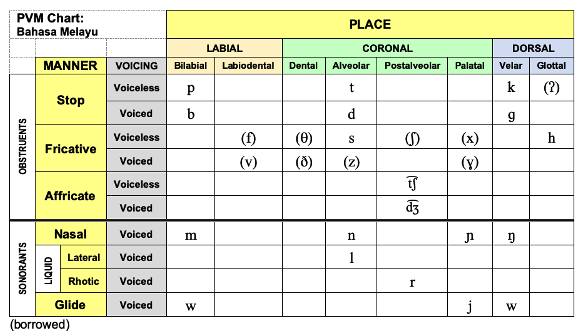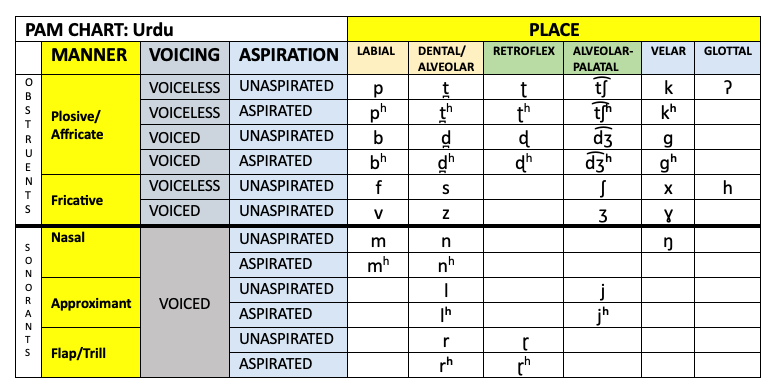CPD - Resources
- Details
- Created: Sunday, 06 November 2011 08:18
- Updated on Sunday, 29 October 2023 12:34

The CPD Resources page contains links to product pages for resources mentioned in Continuing Professional Development (CPD) events with Caroline Bowen. There are also articles of interest and a small selection of intervention materials to download. Other resources link from the Resources Tab at the top of every page of this site.
To become a member of the the private Facebook Group, International Speech Sound Disorders Discussion for SLPs/SLTs (E3PBforSSD) click "Join Group", HERE, and answer three questions.
The CPD Events page comprises a listing of past and forthcoming presentations by Caroline Bowen.
CPD Information for Potential Hosts
CPD Information for Potential Hosts
The CPD Information for Potential Hosts page contains a list of available presentations ("training") with outlines and learner objectives. These range from 1-hour talks, to study days, to 2-day or 3-day presentations, to longer courses. Further information (speakers' fee, AV request, travel and accommodation costs, cancellation policy, etc.) is available, in the Information for Potential Hosts document, on request. e-mail. Please note that this informaton is not available online.
CPD Resources
See below.
Assessment
- Child Speech Assessment Resources [THIS SITE]
- Diagnostic Evaluation of Articulation and Phonology (DEAP)
- Phonetic and Phonological Systems Analysis (PPSA)
- Toddler Phonology Test (TPT)
Charts and diagrams
Please avoid downloading the same file multiple times as it increases my bandwidth usage and drives up my costs. Choose a pdf or pptx file; download it once, and save it to a folder. If you find the free resources here useful, and would like to make your secure donation to the maintenance of this site, please click here, and then click on the DONATE BUTTON.
Consonant charts
Bahasa Indonesia (Indonesian)
Place-Voice-Manner (PVM) Chart and Vowel Chart: Bahasa Indonesia .pdf
Place-Voice-Manner (PVM) Chart: Bahasa Indonesia .png
Bahasa Melayu (Malaysian)
Place-Voice-Manner (PVM) Chart: Bahasa Melayu.png
Bangla
Place-Aspiration-Voice (PAM) Chart: Bangla.pdf
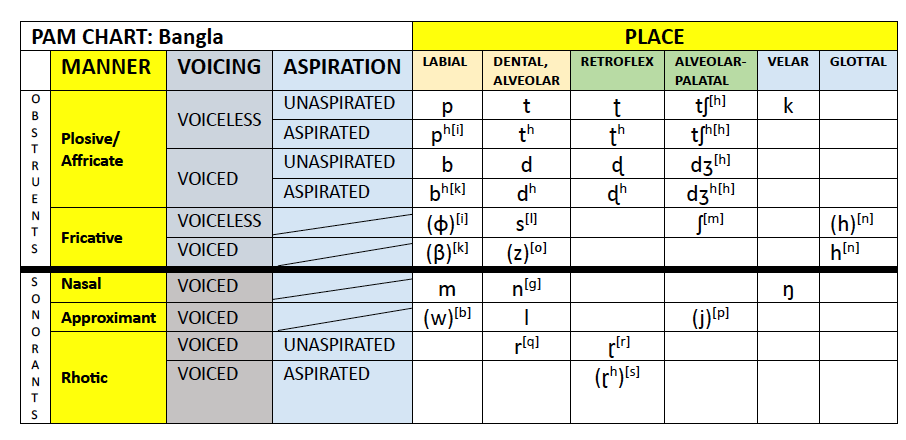
Cantonese
Place-Aspiration-Manner (PAM) Chart: Cantonese .png
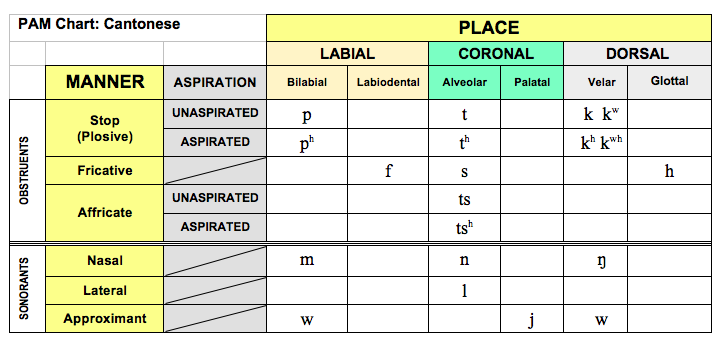
Danish
Place-Voice-Manner (PVM) Chart and Vowel Chart: Danish .pdf
Place-Voice-Manner (PVM) Chart: Danish .png

English
Place-Voice-Manner (PVM) Chart: English .png

Icelandic
Place-Voice-Manner (PVM) Chart: Icelandic .pdf
Place-Voice-Manner (PVM) Chart: Icelandic .png

Másdóttir, T. (2008). Phonological development and disorders in Icelandic-speaking children. Unpublished doctoral dissertation. University of Newcastle.
Irish
Place-Voice-Manner (PVM) Chart: Irish - two charts .pdf
Place-Voice-Manner (PVM) Chart: Irish - two charts .png

Place-Voice-Manner (PVM) Chart: Irish - Chart 1 .png

Place-Voice-Manner (PVM) Chart: Irish - Chart 2 with columns for broad and slender consonants .png
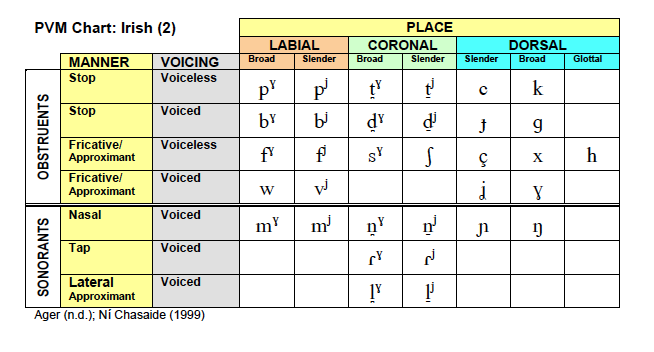
Norwegian
Place-Voice-Manner (PVM): Norwegian .png
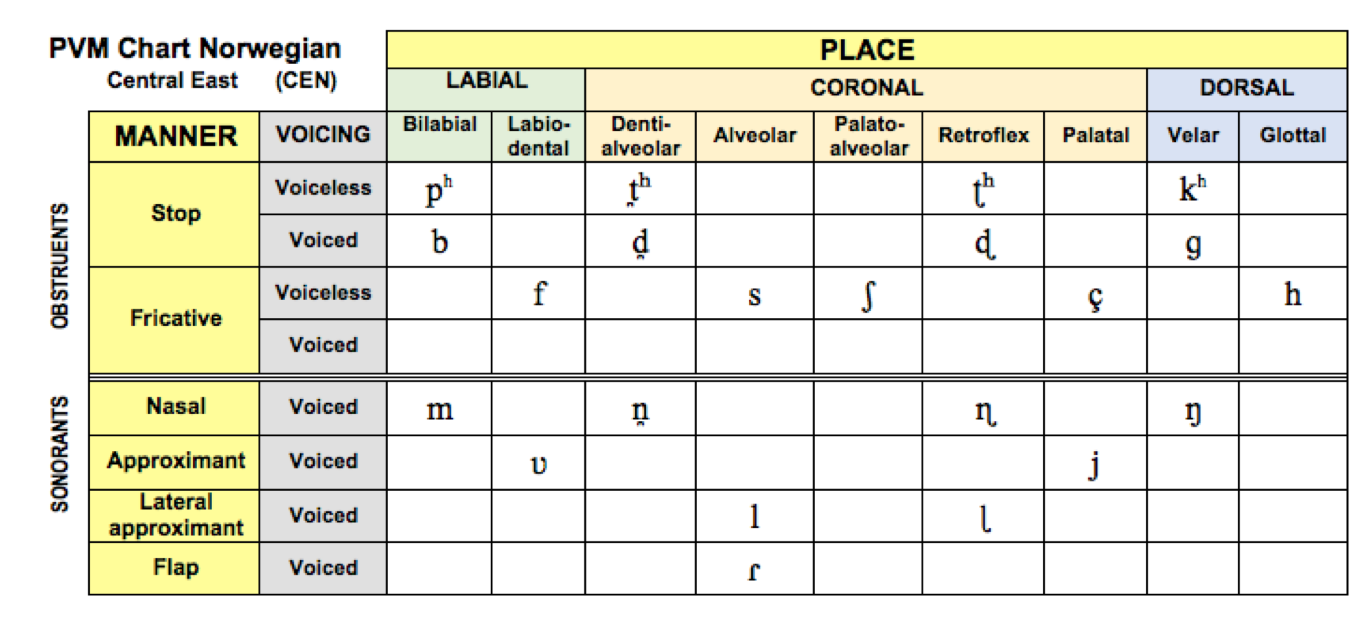
Portuguese
Place-Voice-Manner (PVM) Chart: Portuguese .png

Tagalog

Place-Voice-Manner (PVM) Chart: Tagalog.png
Thai
Place-Aspiration-Manner (PAM) Chart: Thai.png
Turkish
Place-Voice-Manner (PVM) Chart: Turkish .png

Urdu
Place-Aspiration-Manner (PAM) Chart: Urdu.png
Farooq, M., & Mahmood, A. (2021). The Acoustic Effect of Urdu Phonological Rules on English Speech. Linguistics and Literature Review, 7(1), 83-97. https://doi.org/10.32350/llr.71.07 (PDF)
Vowel charts
Vowel chart: Bahasa Indonesia .png




Vowel symbols for broad transcription of Australian English .pdf
Vowel symbols for broad transcription of Australian English .png
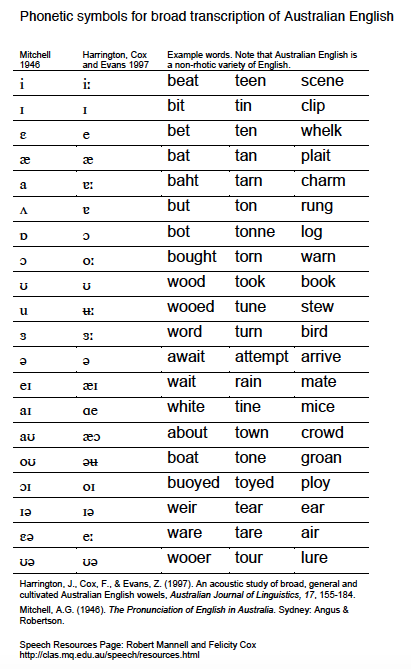
Speech Sound Disorders Umbrella

Intervention materials - free resources
Please avoid downloading the same file multiple times as it increases my bandwidth usage and drives up my costs. Choose a pdf or pptx file; download it once, and save it to a folder. If you find the free resources here useful, and would like to make your secure donation to the maintenance of this site, please click here, and then click on the DONATE BUTTON.
- Einstein (6) [THIS SITE]
- Einstein (20) [THIS SITE]
- Miccio Character Cards 7 pages - Updated 2012 [THIS SITE]
- Pigs in Hiding (video)
- Resources Index [THIS SITE]
Interventions - free resources

The "Lighthouse Page" for "Sound Reasoning"
Articles
Please read this before downloading pdf or pptx files
Please avoid downloading the same file multiple times as doing so increases my bandwidth usage and drives up the cost of maintaining this site. Choose a pdf or pptx file; download it once, and save it to a folder.
ASHA (2007). Position Statement on Childhood Apraxia of Speech. WEB VERSION | PDF VERSION
ASHA (2007). Technical Report on Childhood Apraxia of Speech. WEB VERSION | PDF VERSION
Baker, E. (2004). Phonological analysis, summary and management plan. ACQuiring Knowledge in Speech, Language and Hearing, 6(1), 14-21. Copyright 2004 Speech Pathology Australia. Uploaded by permission. part 1 and part 2
Barlow, J. A., and Gierut, J. A. (2002). Minimal pair approaches to phonological remediation. Seminars in Speech and Language, 23(1), 57-67. Click here and Click here (important to read both of these)
Bernhardt, B., & Major, E. (2005). Speech, language and literacy skills 3 years later: A follow-up study of early phonological and metaphonological intervention.International Journal of Language and Communication Disorders, 40, 1-27. Click here
Betz, S. K. & Stoel-Gammon, C. (2005). Measuring articulatory error consistency in children with developmental apraxia of speech. Clinical Linguistics and Phonetics. January-February, 53-66. Click here
Crosbie, S., Holm, A. & Dodd, B. (2005). Intervention for children with severe speech disorder: A comparison of two approaches. International Journal of Language and Communication Disorders, 40, 467 - 491. Click here
Davis, B.L. & Velleman, S.L. (2000). Differential Diagnosis and Treatment of Developmental Apraxia of Speech in Infants and Toddlers.Infant Toddler Intervention: The Trans-disciplinary Journal, 10(3), pp. 177 - 192. Click here LARGE FILE - opens in a new window
Finn, P. Bothe, A. & Bramlett, R. (2005, August). Science and pseudoscience in communication disorders: Criteria and applications. American Journal of Speech-Language Pathology, 14, 172-186. Click here
Hodson, B. W. (2006). Identifying phonological patterns and projecting remediation cycles: Expediting intelligibility gains of a 7 year old Australian Child. Advances in Speech-Language Pathology, 8(3), 257 - 264. Copyright 2006 Speech Pathology Australia. Uploaded by permission. Click here
Maassen B. (2002). Issues contrasting adult acquired versus developmental apraxia of speech. Seminars in Speech and Language. 23(4), 257-266. Click here
Miccio, A. W., Elbert, M., & Forrest, K. (1999). The Relationship Between Stimulability and Phonological Acquisition in Children With Normally Developing and Disordered Phonologies. American Journal of Speech-Language Pathology, 8, 347-363. Click here
Murray, E., McCabe, P., & Ballard, K. (2012) A comparison of two treatments for childhood apraxia of speech: methods and treatment protocol for a parallel group randomised control trial BMC Pediatrics 12:112. Click here
Peppe, S. and McCann, J. (2003). Assessing intonation and prosody in children with atypical language development: the PEPS-C test and the revised version. Clinical Linguistics and Phonetics, 17/4-5, 345-354. Click here
Peter, B. and Stoel-Gammon, C. (2005). Timing errors in two children with suspected childhood apraxia of speech (sCAS) during speech and music-related tasks. Clinical Linguistics & Phonetics, 19(2), 67-87. Click here
Royal College of Speech and Language Therapists (2011). RCSLT Position Paper on Developmental Verbal Dyspraxia, Author. (RCSLT, 2011).
Rvachew, S., Hodge, M., & Ohberg, A. (2005). Obtaining and Interpreting Maximum Performance Tasks from Children: A Tutorial. Journal of Speech Language Pathology and Audiology, 146-157. Click here
Shriberg, L.D., Campbell, T.F., Karlsson, H.B., McSweeney, J.L., Nadler, C.J. (2003). A diagnostic marker for childhood apraxia of speech: The lexical stress ratio. Clinical Linguistics and Phonetics, 17(7), 549-574. Click here
Shriberg, L. D., Kent, R. D., Karlsson, H. B., McSweeny, J. L., Nadler, C. J., & Brown, R. L. (2003). A diagnostic marker for speech delay associated with otitis media with effusion: backing of obstruents. Clinical Linguistics & Phonetics, 17(7), 529 - 547. Click here
Stackhouse, J., Wells, B., Pascoe, M., & Rees, R. (2002). From phonological therapy to phonological awareness. Seminars in Speech and Language, 23(1), 27-42. Click here
Velleman, S. (2002). Phonotactic therapy. Seminars in Speech and Language, 23, 43-57. Click here
Waisman Phonology Project Publications and Presentations
Watts, N. (2004). Assessment of vowels summary. ACQuiring Knowledge in Speech, Language and Hearing (ACQ), 6(1), 22-25. Speech Pathology Australia. Uploaded by permission. Click here
Williams, A. L. (2003). Letter to the editor: On Minimal Pair Approaches to Phonological Remediation. Seminars in Speech and Language, 24(3), 257-258. Click here


